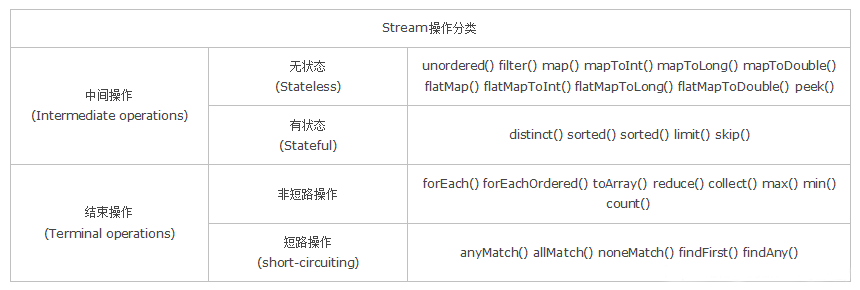简介
说明
本文用实例介绍stream的使用。
JDK8新增了Stream(流操作) 处理集合的数据,可执行查找、过滤和映射数据等操作。
使用Stream API 对集合数据进行操作,就类似于使用 SQL 执行的数据库查询。可以使用 Stream API 来并行执行操作。
简而言之,Stream API 提供了一种高效且易于使用的处理数据的方式。
特点
- 不是数据结构,不会保存数据。
- 大部分不修改原来的数据源,它会将操作后的数据保存到另外一个对象中。
- peek方法可以修改流中元素
- 惰性求值,流在中间处理过程中,只对操作进行记录,不会立即执行,需等到执行终止操作的时候才会进行实际的计算。
Stream操作步骤
创建Stream=> 转换Stream(中间操作)=> 产生结果(终止操作)
注意:这只是一般操作。实际编程时,创建必须有,而中间操作与终止操作是可选的。
操作分类

- 无状态:指元素的处理不受之前元素的影响;
- 有状态:指该操作只有拿到所有元素之后才能继续下去。
- 非短路操作:指必须处理所有元素才能得到最终结果;
- 短路操作:指遇到某些符合条件的元素就可以得到最终结果,如 A || B,只要A为true,则无需判断B的结果。
本文的公共代码
import lombok.Data;
@Data
public class User {
private String name;
private Integer age;
public User(String name, Integer age) {
this.name = name;
this.age = age;
}
}
操作1:创建流
Collection下的 stream() 和 parallelStream() 方法
List<String> list = new ArrayList<>(); Stream<String> stream = list.stream(); //串行流 Stream<String> parallelStream = list.parallelStream(); //并行流
Arrays 中的 stream() 方法,将数组转成流
Integer[] nums = new Integer[10]; Stream<Integer> stream = Arrays.stream(nums);
Stream中的静态方法:of()、iterate()、generate()
Stream<Integer> stream = Stream.of(1,2,3,4,5,6); stream.forEach(System.out::println); // 输出:1 2 3 4 5 6 Stream<Integer> stream2 = Stream.iterate(0, (x) -> x + 2).limit(6); stream2.forEach(System.out::println); // 输出:0 2 4 6 8 10 Stream<Double> stream3 = Stream.generate(Math::random).limit(2); stream3.forEach(System.out::println); // 输出:两个随机数
BufferedReader.lines() 方法,将每行内容转成流
BufferedReader reader = new BufferedReader(new FileReader("F:\\test_stream.txt"));
Stream<String> lineStream = reader.lines();
lineStream.forEach(System.out::println);
Pattern.splitAsStream() 方法,将字符串分隔成流
Pattern pattern = Pattern.compile(",");
Stream<String> stringStream = pattern.splitAsStream("a,b,c,d");
stringStream.forEach(System.out::println);
//输出:a b c d
操作2:中间操作
筛选(过滤)、去重
方法
| 方法 | 说明 |
| filter | 过滤流中的某些元素(只保留返回值为true的项) |
| limit(n) | 获取前n个元素 |
| skip(n) | 跳过前n个元素,配合limit(n)可实现分页 |
| distinct | 通过流中元素的 hashCode() 和 equals() 去除重复元素 |
单个元素筛选(过滤)、去重、跳过、获取前n个
List<Integer> list = new ArrayList<>(Arrays.asList(6, 4, 6, 7, 3, 9, 8, 10, 12, 14, 14));
List<Integer> newList = list.stream()
.filter(s -> s > 5) //6 6 7 9 8 10 12 14 14
.distinct() //6 7 9 8 10 12 14
.skip(2) //9 8 10 12 14
.limit(2) //9 8
.collect(Collectors.toList());
根据对象属性去重
List<User> list = new ArrayList<User>() {{
add(new User("Tony", 20, "12"));
add(new User("Pepper", 20, "123"));
add(new User("Tony", 22, "1234"));
add(new User("Tony", 22, "12345"));
}};
//只通过名字去重
List<User> streamByNameList = list.stream().collect(Collectors.collectingAndThen(
Collectors.toCollection(() -> new TreeSet<>(Comparator.comparing(User::getName))), ArrayList::new
));
System.out.println(streamByNameList);
//[User{name='Pepper', age=20, Phone='123'},
// User{name='Tony', age=20, Phone='12'}]
//通过名字和年龄去重
List<User> streamByNameAndAgeList = list.stream().collect(Collectors.collectingAndThen(
Collectors.toCollection(
() -> new TreeSet<>(Comparator.comparing(o -> o.getName() + o.getAge()))), ArrayList::new
));
System.out.println(streamByNameAndAgeList);
//[User{name='Pepper', age=20, Phone='123'},
// User{name='Tony', age=20, Phone='12'},
// User{name='Tony', age=22, Phone='1234'}]
collectingAndThen 这个方法的意思是: 将收集的结果转换为另一种类型。
因此上面的方法可以理解为:把 new TreeSet<>(Comparator.comparingLong(BookInfoVo::getRecordId))这个set转换为 ArrayList。
映射
方法
| 方法 | 说明 |
| map | 函数作为参数,该函数被应用到每个元素,并将其映射成一个新的元素。新值类型可以和原来的元素的类型不同。 |
| flatMap | 函数作为参数,将流中每个值换成另一个流,再把所有流连成一个流。 新值类型可以和原来的元素的类型不同。 |
| mapToInt/Long/Double | 跟map差不多。只是将其转为基本类型。 |
| flatMapToInt/Long/Double | 跟flatMap差不多。只是将其转为基本类型。 |
新值类型和原来的元素的类型相同示例
List<String> list = Arrays.asList("a,b,c", "1,2,3");
//将每个元素转成一个新的且不带逗号的元素
Stream<String> s1 = list.stream().map(s -> s.replaceAll(",", ""));
s1.forEach(System.out::println);
// abc 123
Stream<String> s2 = list.stream().flatMap(s -> {
//将每个元素转换成一个stream
String[] split = s.split(",");
Stream<String> s3 = Arrays.stream(split);
return s3;
});
s2.forEach(System.out::println);
// a b c 1 2 3
新值类型和原来的元素的类型不同示例
User u1 = new User("aa", 10);
User u2 = new User("bb", 20);
User u3 = new User("cc", 10);
List<User> list = Arrays.asList(u1, u2, u3);
Set<Integer> ageSet = list.stream().map(User::getAge).collect(Collectors.toSet());
ageSet.forEach(System.out::println);
//20 10
int[] ageInt = list.stream().map(User::getAge).mapToInt(Integer::intValue).toArray();
//下边这样也可以
//Integer[] ages = list.stream.map(User::getAge).toArray(Integer[]::new);
for (int i : ageInt) {
System.out.println(i);
}
//10 20 10
map的原型为:<R> Stream<R> map(Function<? super T, ? extends R> mapper);
上边例子中,将Student::getAge作为参数,其实际为:<R> Stream<Integer> map(Function<? super Student, ? extends Integer> mapper);
排序
方法
| 方法 | 说明 |
| sorted() | 自然排序(从小到大),流中元素需实现Comparable接口。 例:list.stream().sorted() |
| sorted(Comparator com) | 定制排序。常用以下几种: list.stream().sorted(Comparator.reverseOrder()) //倒序排序(从大到小) list.stream().sorted(Comparator.comparing(Student::getAge)) //顺序排序(从小到大) list.stream().sorted(Comparator.comparing(Student::getAge).reversed()) // 倒序排序(从大到小) |
示例1:原始类型排序
List<String> list = Arrays.asList("aa", "ff", "dd");
//String 类自身已实现Comparable接口
list.stream().sorted().forEach(System.out::println);
结果:
aa dd ff
示例2:对象单字段排序
User u1 = new User("dd", 40);
User u2 = new User("bb", 20);
User u3 = new User("aa", 20);
User u4 = new User("aa", 30);
List<User> userList = Arrays.asList(u1, u2, u3, u4);
//按年龄升序
userList.stream().sorted(Comparator.comparing(User::getAge))
.forEach(System.out::println);
结果
User(name=bb, age=20) User(name=aa, age=20) User(name=aa, age=30) User(name=dd, age=40)
示例3:对象多字段、全部升序排序
先按年龄升序,年龄相同则按姓名升序
User u1 = new User("dd", 40);
User u2 = new User("bb", 20);
User u3 = new User("aa", 20);
User u4 = new User("aa", 30);
List<User> userList = Arrays.asList(u1, u2, u3, u4);
// 写法1(推荐)
userList.stream()
.sorted(Comparator.comparing(User::getAge)
.thenComparing(User::getName)
// 可以写多个.thenComparing
)
.forEach(System.out::println);
System.out.println("------------------------------------");
// 写法2
userList.stream().sorted(
(o1, o2) -> {
String tmp1 = o1.getAge() + o1.getName();
String tmp2 = o2.getAge() + o2.getName();
return tmp1.compareTo(tmp2);
}
).forEach(System.out::println);
System.out.println("------------------------------------");
// 写法3
userList.stream().sorted(
(o1, o2) -> {
if (!o1.getAge().equals(o2.getAge())) {
return o1.getAge().compareTo(o2.getAge());
} else {
return o1.getName().compareTo(o2.getName());
}
}
).forEach(System.out::println);
结果
User(name=aa, age=20) User(name=bb, age=20) User(name=aa, age=30) User(name=dd, age=40) ------------------------------------ User(name=aa, age=20) User(name=bb, age=20) User(name=aa, age=30) User(name=dd, age=40) ------------------------------------ User(name=aa, age=20) User(name=bb, age=20) User(name=aa, age=30) User(name=dd, age=40)
示例4:对象多字段、升序+降序
先按年龄升序,年龄相同则按姓名降序
User u1 = new User("dd", 40);
User u2 = new User("bb", 20);
User u3 = new User("aa", 20);
User u4 = new User("aa", 30);
List<User> userList = Arrays.asList(u1, u2, u3, u4);
userList.stream().sorted(
(o1, o2) -> {
if (!o1.getAge().equals(o2.getAge())) {
return o1.getAge().compareTo(o2.getAge());
} else {
return o2.getName().compareTo(o1.getName());
}
}
).forEach(System.out::println);
结果
User(name=bb, age=20) User(name=aa, age=20) User(name=aa, age=30) User(name=dd, age=40)
消费
方法
| 方法 | 说明 |
| peek | 类似于map,能得到流中的每一个元素。 但map接收的是一个Function表达式,有返回值; 而peek接收的是Consumer表达式,没有返回值。 |
示例
User u1 = new User("dd", 40);
User u2 = new User("bb", 20);
User u3 = new User("aa", 20);
User u4 = new User("aa", 30);
List<User> list = Arrays.asList(u1, u2, u3, u4);
List<User> list1 = list.stream()
.peek(o -> o.setAge(100))
.collect(Collectors.toList());
System.out.println(list1);
结果:
[User{name='dd', age=100}, User{name='bb', age=100}, User{name='aa', age=100}, User{name='aa', age=100}]
操作3:终止操作
匹配、最值、个数
方法
| 方法 | 说明 |
| allMatch | 接收一个 Predicate 函数,当流中每个元素都符合该断言时才返回true,否则返回false |
| noneMatch | 接收一个 Predicate 函数,当流中每个元素都不符合该断言时才返回true,否则返回false |
| anyMatch | 接收一个 Predicate 函数,只要流中有一个元素满足该断言则返回true,否则返回false |
| findFirst | 返回流中第一个元素 |
| findAny | 返回流中的任意元素 |
| count | 返回流中元素的总个数 |
| max | 返回流中元素最大值 |
| min | 返回流中元素最小值 |
实例1:单个类型
List<Integer> list = Arrays.asList(1, 2, 3, 4, 5); // 匹配 boolean allMatch = list.stream().allMatch(e -> e > 10); //false boolean noneMatch = list.stream().noneMatch(e -> e > 10); //true boolean anyMatch = list.stream().anyMatch(e -> e > 4); //true // 获取第一个/第任意个 Integer findFirst = list.stream().findFirst().get(); //1 Integer findAny = list.stream().findAny().get(); //1 // 计数、最大值、最小值 long count = list.stream().count(); //5 Integer max = list.stream().max(Integer::compareTo).get(); //5 Integer min = list.stream().min(Integer::compareTo).get(); //1
实例2:获取对象中的字段的最值
User u1 = new User("dd", 40);
User u2 = new User("bb", 20);
User u3 = new User("aa", 20);
User u4 = new User("aa", 30);
List<User> list = Arrays.asList(u1, u2, u3, u4);
//获取最小年龄的用户。
User user1 = list.stream()
.min(Comparator.comparing(User::getAge))
.orElse(null);
System.out.println(user1);
System.out.println("------------------------------------");
//获取先按姓名升序,姓名相同则按年龄升序。然后获取最小的那个(第一个)
User user = list.stream().min((o1, o2) -> {
if (o1.getAge().equals(o2.getAge())) {
return o1.getName().compareTo(o2.getName());
} else {
return o1.getAge().compareTo(o2.getAge());
}
}).orElse(null);
System.out.println(user);
结果
User{name='bb', age=20}
------------------------------------
User{name='aa', age=20}
收集
方法
| 方法 | 说明 |
| collect | 接收一个Collector实例,将流中元素收集成另外一个数据结构。 |
Collector实例一般由Collectors的静态方法取得。例如:Collectors.toList()
公共代码
User u1 = new User("dd", 40);
User u2 = new User("bb", 20);
User u3 = new User("aa", 20);
User u4 = new User("aa", 30);
List<User> list = Arrays.asList(u1, u2, u3, u4);
转换
字符串分隔符连接
String joinName = list.stream().map(User::getName).collect(Collectors.joining(",", "(", ")"));
System.out.println(joinName);
//(dd,bb,aa,aa)
转成list
List<Integer> ageList = list.stream().map(User::getAge).collect(Collectors.toList()); System.out.println(ageList); //[40, 20, 20, 30]
转成set
Set<Integer> ageSet = list.stream().map(User::getAge).collect(Collectors.toSet()); System.out.println(ageSet); //[20, 40, 30]
转成map(注:key不能相同,否则报错)
User s1 = new User("dd", 40);
User s2 = new User("bb", 20);
User s3 = new User("aa", 20);
List<User> list = Arrays.asList(s1, s2, s3);
// value为对象中的属性
Map<String, Integer> ageMap = list.stream().collect(Collectors.toMap(User::getName, User::getAge));
System.out.println(ageMap);
//{aa=20, bb=20, dd=40}
// value为对象
Map<String, User> userMap = list.stream().collect(Collectors.toMap(User::getName, user -> user));
// 或者这么写:
// Map<String, User> userMap = list.stream().collect(Collectors.toMap(User::getName, Function.identity()));
System.out.println(userMap);
//{aa=User{name='aa', age=20}, bb=User{name='bb', age=20}, dd=User{name='dd', age=40}}
本处我将重复的名字给去掉了一个,因为如果key有重复的会报错。
三个参数的map
第一个参数:用来生成key值的
第二个参数:用来生成value值的
第三个参数:用在key值冲突的情况下:若新元素产生的key在Map中已经出现过了,第三个参数就会定义解决的办法。
User u1 = new User("aa", 10);
User u2 = new User("bb", 20);
User u3 = new User("cc", 10);
User u4 = new User("bb", 30);
List<User> list = new ArrayList<>(Arrays.asList(u1, u2, u3, u4));
Map<String, List<User>> listMap = list.stream().collect(Collectors.toMap(User::getName,
o -> {
List<User> list1 = new ArrayList<>();
list1.add(o);
return list1;
},
(r1, r2) -> {
r1.addAll(r2);
return r1;
}
)
);
System.out.println(listMap);
结果
{aa=[User{name='aa', age=20}, User{name='aa', age=30}], bb=[User{name='bb', age=20}], dd=[User{name='dd', age=40}]}
聚合
聚合(总数、平均值、最大最小值等)
//1.用户总数
Long count = list.stream().collect(Collectors.counting());
System.out.println(count);
//4
//2.最大年龄 (最小的minBy同理)
Integer maxAge = list.stream().map(User::getAge).collect(Collectors.maxBy(Integer::compare)).get();
System.out.println(maxAge);
//40
//3.所有人的年龄
Integer sumAge = list.stream().collect(Collectors.summingInt(User::getAge));
System.out.println(sumAge);
//110
//4.平均年龄
Double averageAge = list.stream().collect(Collectors.averagingDouble(User::getAge));
System.out.println(averageAge);
// 27.5
// 统计上边所有数据
DoubleSummaryStatistics stat = list.stream().collect(Collectors.summarizingDouble(User::getAge));
System.out.println("count:" + stat.getCount() + " max:" + stat.getMax() + " sum:" + stat.getSum()
+ " average:" + stat.getAverage());
//count:4 max:40.0 sum:110.0 average:27.5
分组
分组(单字段)
//根据年龄分组
Map<Integer, List<User>> listMap = list.stream()
.collect(Collectors.groupingBy(User::getAge));
for (Map.Entry<Integer, List<User>> entry : listMap.entrySet()) {
System.out.println(entry.getKey() + "-->" + entry.getValue());
}
//20-->[User{name='bb', age=20}, User{name='aa', age=20}]
//40-->[User{name='dd', age=40}]
//30-->[User{name='aa', age=30}]
分组(多字段)
Map<String, List<User>> listMap = list.stream()
.collect(Collectors.groupingBy(
user -> {
return user.getAge() + ":" +
user.getName();
}));
for (Map.Entry<String, List<User>> entry : listMap.entrySet()) {
System.out.println(entry.getKey() + "-->" + entry.getValue());
}
//30:aa-->[User(name=aa, age=30)]
//20:aa-->[User(name=aa, age=20)]
//20:bb-->[User(name=bb, age=20)]
//40:dd-->[User(name=dd, age=40)]
多重分组
// 先根据年龄分组再根据名字分组
Map<Integer, Map<String, List<User>>> ageNameMap = list.stream().collect(
Collectors.groupingBy(User::getAge, Collectors.groupingBy(User::getName)));
for (Map.Entry<Integer, Map<String, List<User>>> entry : ageNameMap.entrySet()) {
System.out.println(entry.getKey() + "-->" + entry.getValue());
}
//20-->{aa=[User{name='aa', age=20}], bb=[User{name='bb', age=20}]}
//40-->{dd=[User{name='dd', age=40}]}
//30-->{aa=[User{name='aa', age=30}]}
分区
特殊的分组,分为true和false两组
//分成两部分,一部分大于10岁,一部分小于等于10岁
Map<Boolean, List<User>> partMap = list.stream().collect(Collectors.partitioningBy(v -> v.getAge() > 20));
for (Map.Entry<Boolean, List<User>> entry : partMap.entrySet()) {
System.out.println(entry.getKey() + "-->" + entry.getValue());
}
//false-->[User{name='bb', age=20}, User{name='aa', age=20}]
//true-->[User{name='dd', age=40}, User{name='aa', age=30}]
总结
Collector<T, A, R> 是一个接口,有以下5个抽象方法:
- Supplier<A> supplier():创建一个结果容器A
- BiConsumer<A, T> accumulator():消费型接口,第一个参数为容器A,第二个参数为流中元素T。
- BinaryOperator<A> combiner():函数接口,该参数的作用跟上一个方法(reduce)中的combiner参数一样,将并行流中各个子进程的运行结果(accumulator函数操作后的容器A)进行合并。
- Function<A, R> finisher():函数式接口,参数为:容器A,返回类型为:collect方法最终想要的结果R。
- Set
characteristics():返回一个不可变的Set集合,表明该Collector的特征。有以下三个特征: - CONCURRENT:表示此收集器支持并发。(官方文档还有其他描述,暂时没去探索,故不作过多翻译)
- UNORDERED:表示该收集操作不会保留流中元素原有的顺序。
- IDENTITY_FINISH:表示finisher参数只是标识而已,可忽略。
注:如果对以上函数接口不太理解的话,可参考我另外一篇文章:
Java–Lambda表达式–使用/教程/实例 – 自学精灵
Collectors.toList() 解析
//toList 源码
public static <T> Collector<T, ?, List<T>> toList() {
return new CollectorImpl<>((Supplier<List<T>>) ArrayList::new, List::add,
(left, right) -> {
left.addAll(right);
return left;
}, CH_ID);
}
//为了更好地理解,我们转化一下源码中的lambda表达式
public <T> Collector<T, ?, List<T>> toList() {
Supplier<List<T>> supplier = () -> new ArrayList();
BiConsumer<List<T>, T> accumulator = (list, t) -> list.add(t);
BinaryOperator<List<T>> combiner = (list1, list2) -> {
list1.addAll(list2);
return list1;
};
Function<List<T>, List<T>> finisher = (list) -> list;
Set<Collector.Characteristics> characteristics = Collections.unmodifiableSet
(EnumSet.of(Collector.Characteristics.IDENTITY_FINISH));
return new Collector<T, List<T>, List<T>>() {
@Override
public Supplier supplier() {
return supplier;
}
@Override
public BiConsumer accumulator() {
return accumulator;
}
@Override
public BinaryOperator combiner() {
return combiner;
}
@Override
public Function finisher() {
return finisher;
}
@Override
public Set<Characteristics> characteristics() {
return characteristics;
}
};
}
规约
方法
| 方法 | 说明 |
| Optional<T> reduce(BinaryOperator<T> accumulator) | 第一次执行时,accumulator函数的第一个参数为流中的第一个元素,第二个参数为流中元素的第二个元素; 第二次执行时,第一个参数为第一次函数执行的结果,第二个参数为流中的第三个元素; 依次类推。 |
| T reduce(T identity, BinaryOperator<T> accumulator) | 流程跟上面一样,只是第一次执行时,accumulator函数的第一个参数为identity,而第二个参数为流中的第一个元素。 |
| <U> U reduce(U identity,BiFunction<U, ? super T, U> accumulator,BinaryOperator<U> combiner) | 在串行流(stream)中,该方法跟第二个方法一样,即第三个参数combiner不会起作用。在并行流(parallelStream)中,我们知道流被fork join出多个线程进行执行,此时每个线程的执行流程就跟第二个方法reduce(identity,accumulator)一样,而第三个参数combiner函数,则是将每个线程的执行结果当成一个新的流,然后使用第一个方法reduce(accumulator)流程进行规约。 |
示例
List<Integer> list = Arrays.asList(1, 2, 3, 4, 5);
// 求和
Integer v0 = list.stream().reduce(Integer::sum).orElse(0);
System.out.println(v0);
// 求和
Integer v = list.stream().reduce((x1, x2) -> x1 + x2).orElse(0);
System.out.println(v);
// 15
// 求和(总和加上10)
Integer v1 = list.stream().reduce(10, (x1, x2) -> x1 + x2);
System.out.println(v1);
//25
Integer v2 = list.stream().reduce(0,
(x1, x2) -> {
System.out.println("stream accumulator: x1:" + x1 + " x2:" + x2);
return x1 - x2;
},
(x1, x2) -> {
System.out.println("stream combiner: x1:" + x1 + " x2:" + x2);
return x1 * x2;
});
System.out.println(v2);
// -15
Integer v3 = list.parallelStream().reduce(0,
(x1, x2) -> {
System.out.println("parallelStream accumulator: x1:" + x1 + " x2:" + x2);
return x1 - x2;
},
(x1, x2) -> {
System.out.println("parallelStream combiner: x1:" + x1 + " x2:" + x2);
return x1 * x2;
});
System.out.println(v3);
//-120
打印结果为:
15 15 25 stream accumulator: x1:0 x2:1 stream accumulator: x1:-1 x2:2 stream accumulator: x1:-3 x2:3 stream accumulator: x1:-6 x2:4 stream accumulator: x1:-10 x2:5 -15 parallelStream accumulator: x1:0 x2:3 parallelStream accumulator: x1:0 x2:5 parallelStream accumulator: x1:0 x2:4 parallelStream combiner: x1:-4 x2:-5 parallelStream accumulator: x1:0 x2:2 parallelStream accumulator: x1:0 x2:1 parallelStream combiner: x1:-3 x2:20 parallelStream combiner: x1:-1 x2:-2 parallelStream combiner: x1:2 x2:-60 -120


请先 !